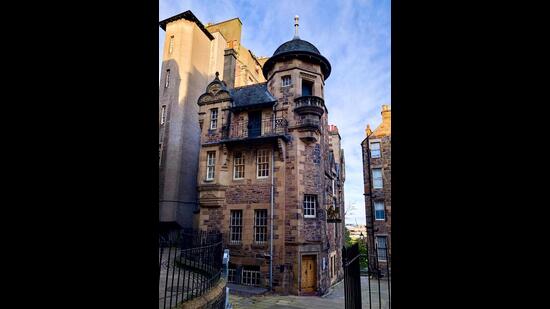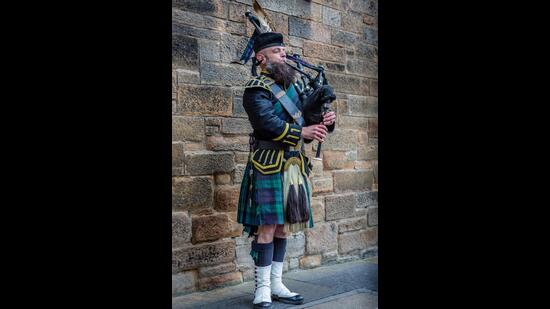Exploring Edinburgh’s rich literary heritage
In the last week of the Edinburgh International Festival, a look at the world’s first UNESCO City of Literature
Of all that I have heard, read, and seen about Edinburgh, author Alexander McCall Smith’s take resonates with me most. “This is a city of shifting light, of changing skies, of sudden vistas. A city so beautiful it breaks the heart again and again.”

The capital of Scotland since the 15th century, Edinburgh, located on the southern shore of the Firth of Forth, is one of the world’s most beautiful cities.

Almost all the structures – whether it is the imposing Edinburgh Castle that stands guard over the city, the baronial St Giles Cathedral, or the stately Palace of Holyroodhouse – seem picture-book perfect, creating the ideal setting for stories of all kinds.
Perhaps that’s why Edinburgh – also known as the “Athens of the North” – was the birthplace of the Scottish Enlightenment. This period in 18th and early 19th century witnessed a torrent of intellectual and scientific accomplishment, which led the city to be called a “hotbed of genius”.

French Enlightenment writer, philosopher and historian Voltaire seemed to acquiesce. In 1762, he wrote: “Today it is from Scotland that we get rules of taste in all the arts, from epic poetry to gardening”. In 1793, American polymath Benjamin Franklin wrote in his autobiography: “Persons of good sense…seldom fall into [disputation], except lawyers, university men, and men of all sorts that have been bred at Edinburgh.”
The cultural milieu has attracted authors, writers, poets, and thinkers down the ages, creating an extremely prolific literary environment. The city has a storied past – it is where the world’s first circulating library was established in 1726, and the first copy of the Encyclopaedia Britannica was published in 1768. In fact, the main train station is also named after a novel: Walter Scott’s Waverley, which was published in 1814 and is said to be the first historical novel in the western tradition.

Ian Teller, the guide taking a motley group of book lovers on a walking tour through Edinburgh, tells us that storytelling and the written word “have been the mainstay of the city’s culture for centuries”.
Edinburgh’s contributions to the world of literature are so many and so well recognised that it was chosen as the world’s first UNESCO City of Literature in 2004. Authors rooted to the city span from Robert Burns, James Hogg, Walter Scott, and Robert Louis Stevenson, and Muriel Spark in the past to JK Rowling, Ian Rankin, Iain Banks, Irvine Welsh, Kenneth Grahame, J.M. Barrie, and Alexander McCall Smith in the present.
There are stories to be read – and seen – everywhere.

The Writers’ Museum, just off the Lawnmarket on Edinburgh’s historic Royal Mile celebrates the lives of three of the finest Scottish writers – Robert Burns, Sir Walter Scott, and Robert Louis Stevenson. Offering free entry, it houses a selection of rare books, portraits, and personal items: a first edition of Scott’s Waverley and the printing press on which his novels were produced; Stevenson’s beloved A Child’s Garden of Verses, his riding boots, and a ring gifted to him by a Samoan chief (engraved with the word Tusitala, meaning “teller of tales”); and Burns’ writing desk, the chair he used to sit on to proofread, and – strangely – a replica of his skull. Contemporary and other writers are often featured in the museum’s temporary exhibitions.
We step out of the museum into the Makars’ Court, a peaceful courtyard that celebrates the life and work of Scottish writers with quotations inscribed in stone and set in the paving. “This national literary monument continues to evolve, with new stones added regularly,” Teller says.
He reveals that the courtyard derives its name from a Scots word for the author of a literary work, particularly a poet or bard: Makar. Since the 19th century, Makar has been used to refer to many poets from earlier centuries, including Robert Henryson, Gavin Douglas, and William Dunbar.
Edinburgh also has its own version of the poet laureate: the Edinburgh Makar. In 2004, the Scottish Parliament also authorised the position of Makar, or National Poet for Scotland. Varied writers have been chosen for the three-year term: Stewart Conn, Valerie Gillies, Ron Butlin, Christine De Luca, and the present Makar Hannah Lavery.

Moving on, we head to the National Library of Scotland, the largest library in Scotland and one of Europe’s most significant research libraries. The volume in this building is stupendous: 24 million printed items, two million maps, and treasures such as copies of the Gutenberg Bible, the last letter written by Mary Queen of Scots, the letter Charles Darwin submitted with the manuscript of On the Origin of Species, the First Folio of Shakespeare, and the archive of Scottish author Muriel Spark.
The Scottish Poetry Library stands out as it is housed in a modernist building on the traditional Royal Mile. The library, which backs the art of poetry in general and the Scottish kind in particular, aims to transform people’s lives through experiences and engagement with poetry – the “spark o’ Nature’s fire”, as Robert Burns wrote. It houses a vast selection of poems, including the complete archives of celebrated Scottish poet Edwin Morgan.

I stop off for a “wee repast”, but decide to indulge in the dish Robert Burns immortalised in his poem, Address to a Haggis. An example of traditional Scottish food, it isn’t for the faint of stomach – or heart: the haggis, a savoury pudding made with sheep’s pluck (heart, liver, and lungs), minced onion, oatmeal, suet, spices, herbs, and seasoning, is served with creamy mashed turnips (neeps) and mashed potatoes (tatties) on the side.
Outside, the pearl grey sky has created the right ambience for a long walk. I see reminders of Edinburgh’s literary riches dotted around the city – poet Robert Fergusson seems to be walking down the Royal Mile; Sherlock Holmes stands on Picardy Place, the birthplace of his creator, Arthur Conan Doyle; Alan Breck and David Balfour, the two heroes of Stevenson’s Kidnapped, can be spotted on Corstorphine Road; while a memorial to Stevenson is located in a grove in Princes Street Gardens.

As instructed by the friendly barkeep, I keep an eye out for plaques placed by Historic Environment Scotland on streets and buildings connected to well-known literary figures and those who didn’t get their due.
The Princes Street Gardens also house the towering Scott Monument, one of the most iconic Edinburgh landmarks and one of the largest monuments to a writer anywhere in the world. The museum room on the first floor reveals the story of the Victorian Gothic structure and the legacy of Sir Walter Scott. At the base of the monument sits the author, carved in Carrara marble by John Steell. Created from single piece of marble weighing 30 tons, the statue features Scott and his beloved dog, Maida.
I return to the Royal Mile’s “literature quarter” to visit the Scottish Storytelling Centre, which showcases Scotland’s culture year-round. The vibrant arts venue offers a seasonal programme of live storytelling, theatre, music, exhibitions, workshops, festivals, and family events. The centre is dedicated to the art of telling stories, and the staff seem to have follow an old Scottish proverb, “The story is told eye to eye, mind to mind and heart to heart”.
If you don’t enjoy walking on your own, there are numerous literary walking tours or poetry walks that retrace the footsteps of authors and poets, in their historical contexts, weaving in and out of streets, gardens, closes, and graveyards. A literary pub tour is equal parts informative and fun. Slainte!

Not content with its literary past, Edinburgh is also regularly working to enhance its bookish present and future.
The city hosts the largest public celebration of books in the world, the Edinburgh International Book Festival, which started in a tent in August 1983 and moved to Charlotte Square Gardens. In 2021, post-Covid, the festival shifted venues again, to Edinburgh College of Art
In 2023, the festival is celebrating its 40th anniversary with events featuring Icelandic prime minister Katrín Jakobsdóttir, former Booker prize winners Ben Okri and Anne Enright, International Booker winners Georgi Gospodinov and David Diop, and climate change activist Greta Thunberg. This year’s festival will feature nearly 600 events, with 470 authors and opinion makers.

Walking around the city, I notice that Edinburgh has more than its fair share of independent bookshops. The much-Instagrammed used bookstore Armchair Books offers “very nearly alphabetised chaos”. But there are many others that are ideal to explore, especially on a dreich (bleak and rainy) day: McNaughton’s, the oldest second-hand and antiquarian bookshop in Scotland; Typewronger Books, a small shop that offers typewriter repairs; Topping & Company Booksellers, which is making a mark on the events calendar; Golden Hare Books, an awarded independent bookshop; Lighthouse Bookshop, which calls itself “politically engaged and socially conscious”, Portobello Bookshop, housed in a space that used to be fishing tackle shop for 30 years; and Tills Bookshop, a gorgeous store that overlooks the Meadows.
Edinburgh also offers readers an option if they don’t want to buy: Exchange. The city seems to be bursting with Little Free Libraries and book exchange boxes that invite you to “have a look and exchange your book”.

As I walk around, I continue to spot literary reminders. JK Rowling’s presence is everywhere: Victoria Street, which inspired her Diagon Alley; George Heriot’s School, which seems to have been on the mood board for Hogwarts; the many cafés she frequented while writing; and the five-star Balmoral Hotel, where she finished Harry Potter and the Deathly Hallows and which now has a posh suite named after her. Fans of crime fiction can hit Oxford Bar, mentioned in Ian Rankin’s Inspector Rebus series, or grab a pint at the Conan Doyle, a pub located across the road from the Sherlock Holmes author’s birthplace.
The Scottish capital’s literary heritage spans centuries, and the stories seem to be set in stone – in the cobbled streets, old monuments, and newer buildings.
Wandering through the streets, soaking in the atmosphere, I realise that there may be many cities of literature now, but none that’s more bookish than Edinburgh.
As Robert Louis Stevenson pronounced long ago: “Half a capital and half a country town, the whole city leads a double existence; it has long trances of the one and flashes of the other; like the king of the Black Isles, it is half alive and half a monumental marble.”
Teja Lele is an independent editor and writes on books, travel and lifestyle
All Access.
One Subscription.
Get 360° coverage—from daily headlines
to 100 year archives.



HT App & Website







